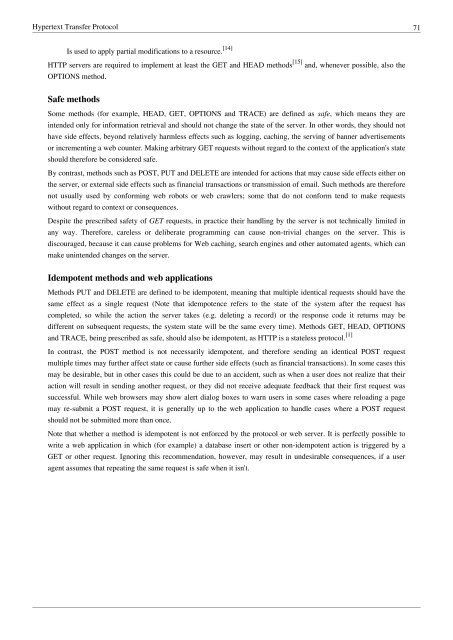Internet Protocol - Research by Kirils Solovjovs
Internet Protocol - Research by Kirils Solovjovs
Internet Protocol - Research by Kirils Solovjovs
You also want an ePaper? Increase the reach of your titles
YUMPU automatically turns print PDFs into web optimized ePapers that Google loves.
Hypertext Transfer <strong>Protocol</strong> 71<br />
Is used to apply partial modifications to a resource. [14]<br />
HTTP servers are required to implement at least the GET and HEAD methods [15] and, whenever possible, also the<br />
OPTIONS method.<br />
Safe methods<br />
Some methods (for example, HEAD, GET, OPTIONS and TRACE) are defined as safe, which means they are<br />
intended only for information retrieval and should not change the state of the server. In other words, they should not<br />
have side effects, beyond relatively harmless effects such as logging, caching, the serving of banner advertisements<br />
or incrementing a web counter. Making arbitrary GET requests without regard to the context of the application's state<br />
should therefore be considered safe.<br />
By contrast, methods such as POST, PUT and DELETE are intended for actions that may cause side effects either on<br />
the server, or external side effects such as financial transactions or transmission of email. Such methods are therefore<br />
not usually used <strong>by</strong> conforming web robots or web crawlers; some that do not conform tend to make requests<br />
without regard to context or consequences.<br />
Despite the prescribed safety of GET requests, in practice their handling <strong>by</strong> the server is not technically limited in<br />
any way. Therefore, careless or deliberate programming can cause non-trivial changes on the server. This is<br />
discouraged, because it can cause problems for Web caching, search engines and other automated agents, which can<br />
make unintended changes on the server.<br />
Idempotent methods and web applications<br />
Methods PUT and DELETE are defined to be idempotent, meaning that multiple identical requests should have the<br />
same effect as a single request (Note that idempotence refers to the state of the system after the request has<br />
completed, so while the action the server takes (e.g. deleting a record) or the response code it returns may be<br />
different on subsequent requests, the system state will be the same every time). Methods GET, HEAD, OPTIONS<br />
and TRACE, being prescribed as safe, should also be idempotent, as HTTP is a stateless protocol. [1]<br />
In contrast, the POST method is not necessarily idempotent, and therefore sending an identical POST request<br />
multiple times may further affect state or cause further side effects (such as financial transactions). In some cases this<br />
may be desirable, but in other cases this could be due to an accident, such as when a user does not realize that their<br />
action will result in sending another request, or they did not receive adequate feedback that their first request was<br />
successful. While web browsers may show alert dialog boxes to warn users in some cases where reloading a page<br />
may re-submit a POST request, it is generally up to the web application to handle cases where a POST request<br />
should not be submitted more than once.<br />
Note that whether a method is idempotent is not enforced <strong>by</strong> the protocol or web server. It is perfectly possible to<br />
write a web application in which (for example) a database insert or other non-idempotent action is triggered <strong>by</strong> a<br />
GET or other request. Ignoring this recommendation, however, may result in undesirable consequences, if a user<br />
agent assumes that repeating the same request is safe when it isn't.


